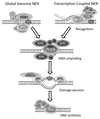A simple answer to complex questions: Caenorhabditis elegans as an experimental model for examining the DNA damage response and disease genes
- PMID: 28463453
- PMCID: PMC5562273
- DOI: 10.1002/jcp.25979
A simple answer to complex questions: Caenorhabditis elegans as an experimental model for examining the DNA damage response and disease genes
Abstract
The genetic information is constantly challenged by genotoxic attacks. DNA repair mechanisms evolved early in evolution and recognize and remove the various lesions. A complex network of DNA damage responses (DDR) orchestrates a variety of physiological adaptations to the presence of genome instability. Erroneous repair or malfunctioning of the DDR causes cancer development and the accumulation of DNA lesions drives the aging process. For understanding the complex DNA repair and DDR mechanisms it is pivotal to employ simple metazoan as model systems. The nematode Caenorhabditis elegans has become a well-established and popular experimental organism that allows dissecting genome stability mechanisms in dynamic and differentiated tissues and under physiological conditions. We provide an overview of the distinct advantages of the nematode system for studying DDR and provide a range of currently applied methodologies.
Keywords: C. elegans; DNA damage response; DNA repair; aging; genome stability.
© 2017 Wiley Periodicals, Inc.
Figures





Similar articles
-
Isolating genes involved with genotoxic drug response in the nematode Caenorhabditis elegans using genome-wide RNAi screening.Methods Mol Biol. 2012;920:27-38. doi: 10.1007/978-1-61779-998-3_3. Methods Mol Biol. 2012. PMID: 22941594
-
Tissue specific response to DNA damage: C. elegans as role model.DNA Repair (Amst). 2015 Aug;32:141-148. doi: 10.1016/j.dnarep.2015.04.025. Epub 2015 May 1. DNA Repair (Amst). 2015. PMID: 25957488 Review.
-
Combined functional genomic maps of the C. elegans DNA damage response.Science. 2002 Jan 4;295(5552):127-31. doi: 10.1126/science.1065986. Science. 2002. PMID: 11778048
-
Genome Instability in Development and Aging: Insights from Nucleotide Excision Repair in Humans, Mice, and Worms.Biomolecules. 2015 Aug 13;5(3):1855-69. doi: 10.3390/biom5031855. Biomolecules. 2015. PMID: 26287260 Free PMC article. Review.
-
Caenorhabditis elegans as a powerful alternative model organism to promote research in genetic toxicology and biomedicine.Arch Toxicol. 2017 May;91(5):2029-2044. doi: 10.1007/s00204-017-1944-7. Epub 2017 Mar 15. Arch Toxicol. 2017. PMID: 28299394 Review.
Cited by
-
Mechanisms of germ cell survival and plasticity in Caenorhabditis elegans.Biochem Soc Trans. 2022 Oct 31;50(5):1517-1526. doi: 10.1042/BST20220878. Biochem Soc Trans. 2022. PMID: 36196981 Free PMC article. Review.
-
Dietary and environmental factors have opposite AhR-dependent effects on C. elegans healthspan.Aging (Albany NY). 2020 Dec 13;13(1):104-133. doi: 10.18632/aging.202316. Epub 2020 Dec 13. Aging (Albany NY). 2020. PMID: 33349622 Free PMC article.
-
Distinct DNA repair mechanisms prevent formaldehyde toxicity during development, reproduction and aging.Nucleic Acids Res. 2024 Aug 12;52(14):8271-8285. doi: 10.1093/nar/gkae519. Nucleic Acids Res. 2024. PMID: 38894680 Free PMC article.
-
Maf1 regulates intracellular lipid homeostasis in response to DNA damage response activation.Mol Biol Cell. 2021 May 15;32(11):1086-1093. doi: 10.1091/mbc.E20-06-0378. Epub 2021 Mar 31. Mol Biol Cell. 2021. PMID: 33788576 Free PMC article.
-
A C. elegans model for neurodegeneration in Cockayne syndrome.Nucleic Acids Res. 2020 Nov 4;48(19):10973-10985. doi: 10.1093/nar/gkaa795. Nucleic Acids Res. 2020. PMID: 33021672 Free PMC article.
References
-
- Alpi A, Pasierbek P, Gartner A, Loidl J. Genetic and cytological characterization of the recombination protein RAD-51 in Caenorhabditis elegans. Chromosoma. 2003;112:6–16. - PubMed
-
- Antebi A. Ageing: when less is more. Nature. 2007;447:536–537. - PubMed
-
- Blum ES, Driscoll M, Shaham S. Noncanonical cell death programs in the nematode Caenorhabditis elegans. Cell Death Differ. 2008;15:1124–1131. - PubMed
Publication types
MeSH terms
Grants and funding
LinkOut - more resources
Full Text Sources
Other Literature Sources
Research Materials

